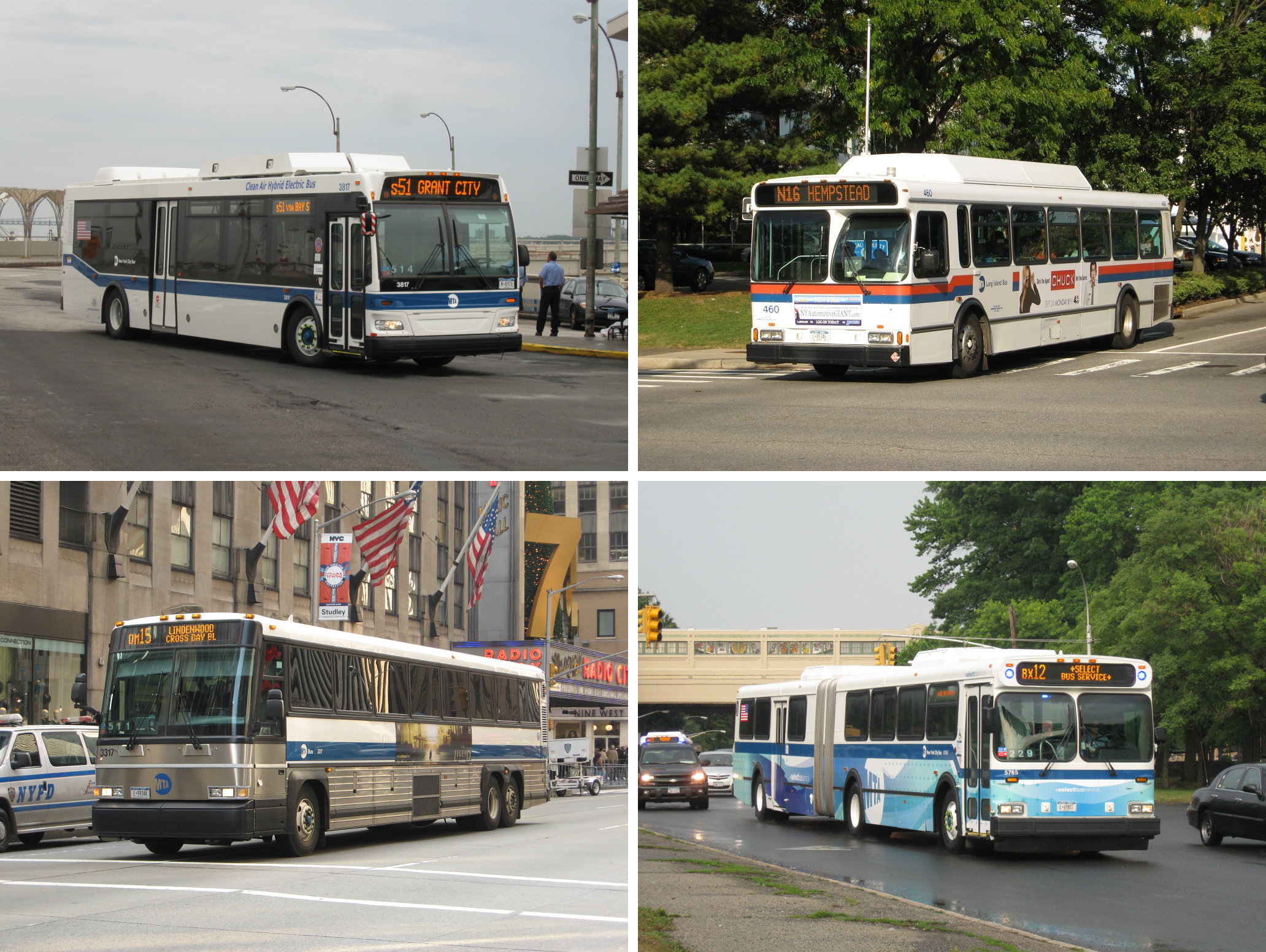- MTA Regional Bus Operations
Infobox Bus transit
name = MTA Regional Bus Operations
logo_size =

image_size = 300px
image_caption = MTA Regional Bus Operations (RBO) provides bus service in southeastern New York service under New York City Bus, Long Island Bus, MTA Bus, and +selectbusservice.
company_slogan = Going Your Way
parent =Metropolitan Transportation Authority (New York)
founded = 2008
headquarters = 2 Broadway
New York, NY 10004
locale =New York metropolitan area
service_area =New York City and Nassau County
service_type = Local, limited-stop, and express bus service
alliance =
routes = 386
destinations =
stops =
hubs =
stations =
lounge =
fleet = 6,251 (bus-fixed route) [http://www.ntdprogram.gov/ntdprogram/pubs/profiles/2007/agency_profiles/2008.pdf NYCT data from the National Transit Database] ] [http://www.ntdprogram.gov/ntdprogram/pubs/profiles/2007/agency_profiles/2007.pdf Long Island Bus data from the National Transit Database] ] [http://www.ntdprogram.gov/ntdprogram/pubs/profiles/2007/agency_profiles/2188.pdf MTA Bus Company data from the National Transit Database] ]
2,116 (ADA paratransit) [http://www.ntdprogram.gov/ntdprogram/pubs/profiles/2007/agency_profiles/2159.pdf Atlantic Express paratransit data from the National Transit Database] ]
(2007 figures)
ridership =
fuel_type =
operator =
ceo = Joseph A. Smith
website = [http://www.mta.info/ Metropolitan Transportation Authority]MTA Regional Bus Operations (referred hereafter as RBO) is the legal name of the surface transit division of the
Metropolitan Transportation Authority (New York) (MTA), created in 2008 to consolidate all bus operations operated by the MTA.cite press release |title=MTA Moves to Streamline Bus Operations|url=http://www.mta.info/mta/news/releases/?en=080507-HQ15|publisher=Metropolitan Transportation Authority (New York) |date=2008-05-08|accessdate=2008-10-06]History
The history of MTA's bus operations generally follows the history of the
New York City Transit Authority , which was created in 1953 by the State of New York to take over operations from the New York City Board of Transportation which were then directly operated by it. The current system came into being following takeover of services operated under contract to theNew York City Department of Transportation , the successor to the Board of Transportation, bringing almost all transportation in New York City under its control in the mid-2000s, following an end-run around the New York State legislature which had sought to block it and after a prolonged strike by workers for several private operators, a plan that was introduced almost as soon asMichael Bloomberg became mayor of New York City in 2002, [cite news|url=http://query.nytimes.com/gst/fullpage.html?res=9F03E7DA163EF936A15755C0A9649C8B63&scp=4&sq=mta%20takes%20over%20triboro%20coach&st=cse|title=City Seeks M.T.A. Takeover Of 7 Bus Companies' Routes|author=Steinhauer, Jennifer|date=2002-06-25|accessdate=2008-10-06|publisher=New York Times ] [cite news|url=http://findarticles.com/p/articles/mi_hb5553/is_200406/ai_n22193417|title=New York City mayor's bus plan bypasses state legislature|author=Lombardi, Frank|date=2004-07-25|accessdate=2008-10-06|publisher=New York Daily News ] which at the time had a fleet average of over 12 years. [cite news|url=http://query.nytimes.com/gst/fullpage.html?res=9C0DE2DA103AF935A15757C0A9629C8B63|date=2004-04-26|author=Kilgannon, Corey|title=Private Buses Pose Challenge For the M.T.A.|publisher=New York Times |accessdate=2008-10-06] Completed in 2006,cite press release |title=MTA Bus Mergers Completed|url=http://mta.info/mta/news/newsroom/mtabus.htm|publisher=Metropolitan Transportation Authority (New York) |date=2006-02-20|accessdate=2008-10-06] the MTA then moved to streamline its operations through consolidation of management function. To that effect, RBO was officially created in May 2008, with the president of what was then New York City Transit's Department of Buses, Joseph A. Smith, named to lead the consolidated bus operations.Currently, RBO's operational changes have been at the management level, with the creation of a unified command center and consolidation of management for all bus operations, with the aim of reducing redundancies in the agency. Other changes will include changes in the way that customers can get their information, such as via PDA.cite news|url=http://blog.silive.com/statenislandtransportation/2008/05/streamlining_buses_saving_cash.html|title=Streamlining Buses, Saving Cash|author=Yates, Maura|publisher=
Staten Island Advance |accessdate=2008-10-06|date=2008-05-07] cite news|url=http://www.thechief-leader.com/news/2008/0516/news/011.html|title=MTA Consolidation Of Bus Units Raises Seniority Concerns |author=Paul, Ari|publisher=The Chief-Leader|date=2008-05-16|accessdate=2008-10-06] One of the questions, however, that remains unresolved under RBO is how operations that have had funding issues historically disputed, such as Long Island Bus, will be funded by municipal government. [cite web|url=http://blog.tstc.org/2008/05/12/long-island-bus-to-find-a-home-as-mta-announces-regional-bus/|title=Long Island Bus to Find a Home as MTA Announces Regional Bus|author=Steven Higashide|date=2008-05-12|accessdate=2008-10-06]The reorganization of bus operations into Regional Bus Operations is part of a wider reorganization of the MTA, which will also include subways and commuter rail.
Brands and service area
RBO currently trades under the following public brands:
*MTA New York City Bus — most routes within the City of New York, formerly under theNew York City Transit Authority
**Select Bus Service — used forbus rapid transit service
*MTA Long Island Bus &mndash; local service in Nassau County, formerly the Metropolitan Suburban Bus Authority
*MTA Bus — service previously controlled by theNew York City Department of Transportation and operated by seven companies at the time of takeover, concentrated in parts of Brooklyn and Queens, and most express bus service into Queens and the Bronx from ManhattanFleet
The RBO fleet, as of 2007, consists of over 6,200 buses of various types and models for fixed-route service, and over 2,000 vans and cabs for ADA paratransit service, providing. All vehicles (except for paratransit cabs) are fully accessible to persons with disabilities.
Fares
The one-way fare on any local bus operated under a brand of MTA RBO is $2.00 USD, payable only with coins or MetroCard (
Select Bus Service fare is paid before boarding, with a receipt given). Discount passes for 1, 7, 14, or 30 days are available. MetroCard is also accepted on Westchester Bee-Line buses for travel into Westchester County. The express bus fare for NYC Transit and MTA Bus express bus service is $5 USD. Dollar bills and half-dollar coins are not accepted for use on fixed-route travel.The fare for ADA paratransit service is $2.00 in New York City and $3.75 in Nassau County. Exact fare is required.
References
External links
* [http://www.mta.info Metropolitan Transportation Authority]
Wikimedia Foundation. 2010.
